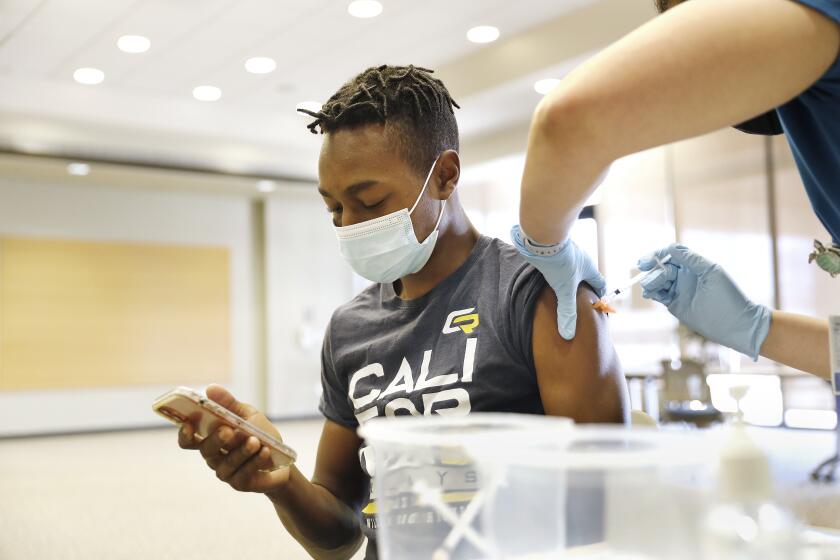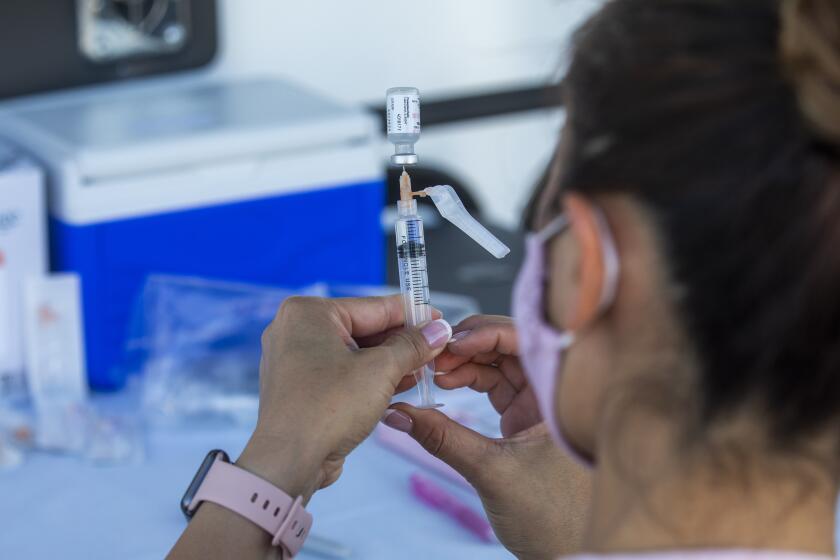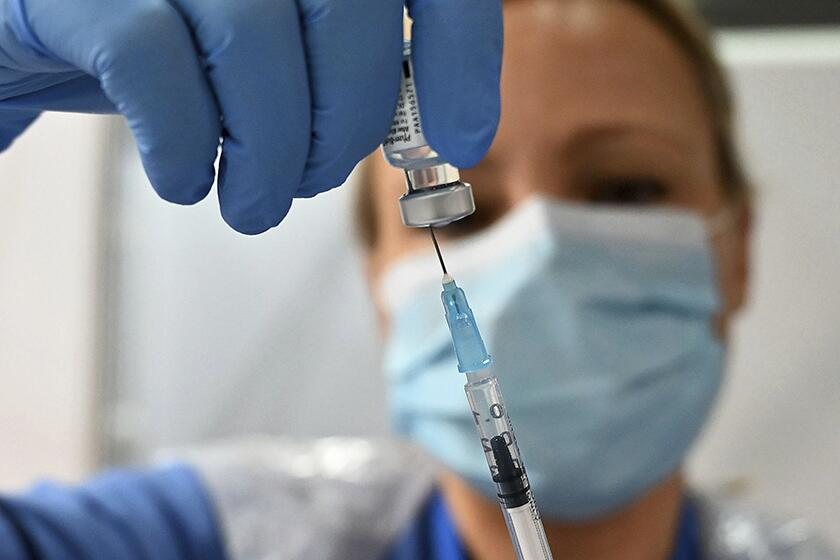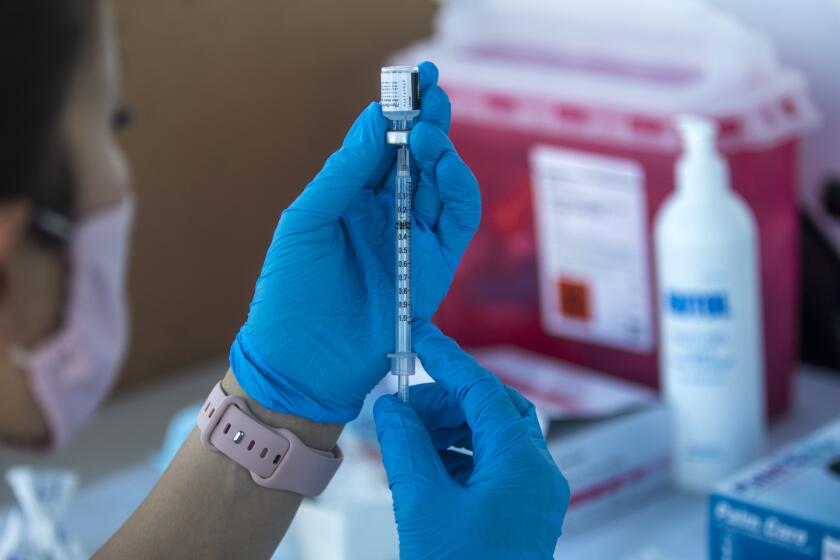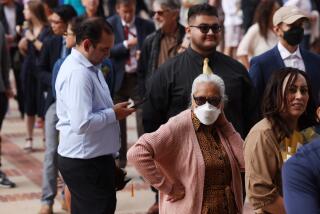COVID-19 rebounding in Orange County, other Southern California suburbs
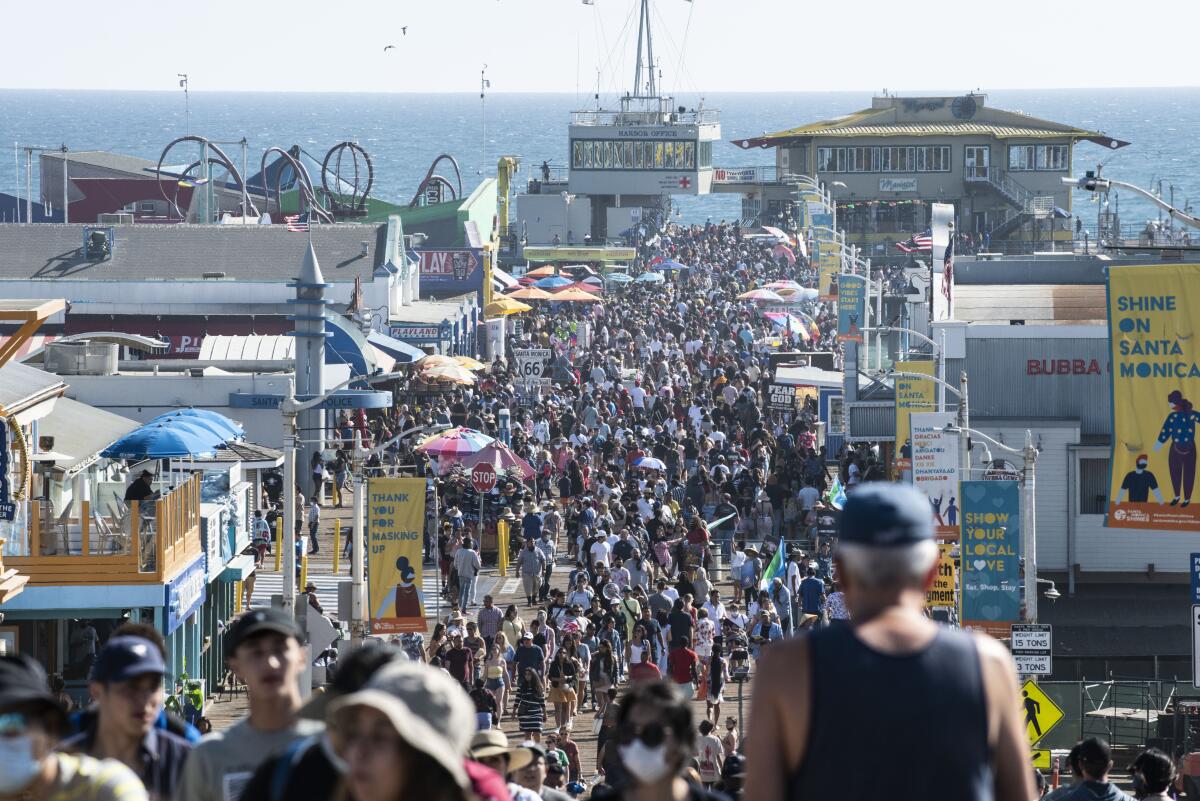
COVID-19 is rebounding across Southern California, swelling the numbers of infections and hospitalizations and prompting fresh calls for residents to get vaccinated.
While their overall numbers remain relatively low compared with the pandemic’s earlier high-water marks, Orange, San Diego and San Bernardino counties have all seen their daily case averages more than triple over the past two weeks — mirroring a trend in Los Angeles County, data compiled by The Times show.
Fourteen days ago, Orange County was reporting a weekly average of about 48 new cases per day. Now, the figure is 150. During that same time, averages grew in San Diego County from 92 cases per day to 344; in San Bernardino County from 55 cases per day to 215; and in L.A. County from 298 cases per day to 983.
Riverside County publicly updates its case count weekly, but its latest numbers were not available as of early Wednesday afternoon.
However, the U.S. Centers for Disease Control and Prevention now considers Riverside, along with L.A. and San Diego, to have “substantial” community transmission — the second-worst classification on the agency’s four-tier scale — as all recently recorded seven-day case rates that were over 50 per 100,000 residents.
The tally marks the fourth consecutive day that new cases totaled more than 1,000, health officials said.
Though cases in these counties are nowhere near the levels of the pandemic’s earlier waves — and there’s optimism the current uptick won’t grow into anything of that magnitude — health officials have long noted that increases in cases are the first warning sign, as more infections could eventually trigger corresponding increases in hospitalizations and, possibly, deaths.
The second phase is now also currently on display in Southern California. On June 29, there were 56 COVID-19 positive patients hospitalized in Orange County, state figures show. As of Tuesday, that number had swelled to 119.
Increases in patients also been reported during that span in San Bernardino County, from 84 to 117; San Diego County, from 74 to 110; Riverside County, from 55 to 94; and Los Angeles County, from 275 to 406.
“We are now seeing about double the number of cases that were being reported a month ago,” San Diego County Public Health Officer Dr. Wilma Wooten said in a statement Tuesday.
She added, “we expect further increases in ICU admissions since they lag behind the trend in cases and hospitalizations.”
Door-to-door outreach and vaccine requirements at work would help curb coronavirus spread, experts say.
These Southern California counties — the state’s five most-populous — reflect the statewide COVID-19 landscape.
Over the past week, California has reported an average of 2,972 new coronavirus cases per day, up 191% from two weeks ago, The Times’ data show.
And since June 29, statewide COVID-19 hospitalizations have risen from 1,089 to 1,648, a 51% jump.
Deaths, however, have not climbed at nearly the same pace. Over the past week, an average of 32 Californians died from COVID-19 per day, an increase of about 23% from two weeks ago.
There are a few factors that likely play into the resurgence, officials and experts say. First, many of the restrictions that long defined California’s pandemic response — including capacity restrictions on businesses, the closure or limitation of indoor spaces and requirements for physical distancing and widespread masking — were lifted on June 15.
“Some increase of cases in remaining unvaccinated persons is anticipated after removing restrictions and increased mixing,” officials with the California Department of Public Health wrote in an email this week.
Then there’s the Delta variant — which presents particular risk, especially to the unvaccinated, as it’s believed to be twice as transmissible as the conventional coronavirus strains.
It’s also California’s most identified variant, accounting for 42.9% of cases analyzed in June, according to state figures released last week.
Still, many experts have said they don’t believe COVID-19’s latest punch will prove as potent as the surges that struck the state last summer and over the fall and winter.
“At this point, this really is a preventable illness, a preventable infection,” said Dr. Christina Ghaly, L.A. County’s director of health services.
The biggest reason for that optimism is the rollout of COVID-19 vaccines, which officials say are highly effective at blunting transmission, and especially at staving off the worst of the disease. Given that many older and higher-risk Californians have already been vaccinated, it’s possible that increases in transmission won’t lead to the same harrowing death tolls as earlier in the pandemic.
“Those that are in the hospitals, those that have died, overwhelmingly are people that have not been vaccinated,” Gov. Gavin Newsom said during a news conference Wednesday. “I cannot impress upon you more the power of getting vaccinated. If we want to extinguish this pandemic, this disease, we’ve got to get vaccinated, period, full stop.”
The UC San Francisco study concludes that vaccine hesitancy could put older adults at risk and further complicate the goal of “herd immunity.”
To date, 51.7% of all Californians are fully vaccinated, Times data show. However, Southern California is a mixed bag.
In San Diego County, the percentage is 56.6; in Orange County, it’s 54.6; and in L.A. County, it’s 52. All have full vaccination coverage above the statewide level.
The rates are much lower in Riverside County (42%) and San Bernardino County (39%).
Officials have urged residents who received their first dose of either Pfizer-BioNTech or Moderna to make sure they complete their inoculation course — as getting only one shot does not provide the full level of protection, including against the Delta variant.
While some may fundamentally reject rolling up their sleeves for a shot, officials say there are many reasons why people may not have gotten vaccinated.
In an online update published by San Bernardino County on July 7, Dr. Rodney Borger, an emergency room physician at Arrowhead Regional Medical Center, said, “We have done an excellent job getting our most vulnerable residents vaccinated. ... However, a substantial portion of our population has declined, or at least delayed, getting a vaccine shot.
“Frankly, there is a segment of the population that has simply refused to get vaccinated, including a number of incarcerated individuals,” Borger continued. “There is little we can do about this group. However, there are other county residents who don’t oppose vaccinations on principle but have simply neglected to get a shot. These are the people we are urging to get vaccinated — if only to protect others, if not themselves.”
Times staff writer Ben Welsh contributed to this report.
More to Read
Sign up for Essential California
The most important California stories and recommendations in your inbox every morning.
You may occasionally receive promotional content from the Los Angeles Times.
